The Intel 9th Gen Review: Core i9-9900K, Core i7-9700K and Core i5-9600K Tested
by Ian Cutress on October 19, 2018 9:00 AM EST- Posted in
- CPUs
- Intel
- Coffee Lake
- 14++
- Core 9th Gen
- Core-S
- i9-9900K
- i7-9700K
- i5-9600K
CPU Performance: Encoding Tests
With the rise of streaming, vlogs, and video content as a whole, encoding and transcoding tests are becoming ever more important. Not only are more home users and gamers needing to convert video files into something more manageable, for streaming or archival purposes, but the servers that manage the output also manage around data and log files with compression and decompression. Our encoding tasks are focused around these important scenarios, with input from the community for the best implementation of real-world testing.
All of our benchmark results can also be found in our benchmark engine, Bench.
Handbrake 1.1.0: Streaming and Archival Video Transcoding
A popular open source tool, Handbrake is the anything-to-anything video conversion software that a number of people use as a reference point. The danger is always on version numbers and optimization, for example the latest versions of the software can take advantage of AVX-512 and OpenCL to accelerate certain types of transcoding and algorithms. The version we use here is a pure CPU play, with common transcoding variations.
We have split Handbrake up into several tests, using a Logitech C920 1080p60 native webcam recording (essentially a streamer recording), and convert them into two types of streaming formats and one for archival. The output settings used are:
- 720p60 at 6000 kbps constant bit rate, fast setting, high profile
- 1080p60 at 3500 kbps constant bit rate, faster setting, main profile
- 1080p60 HEVC at 3500 kbps variable bit rate, fast setting, main profile
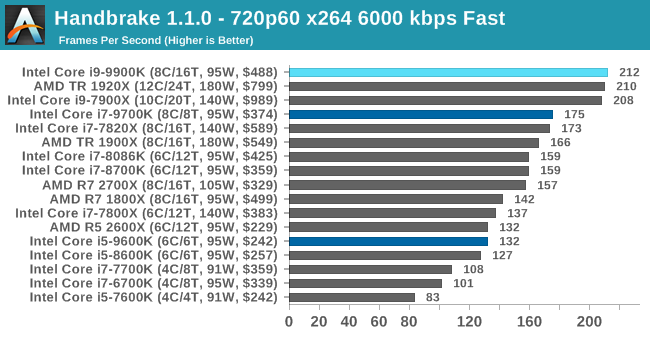
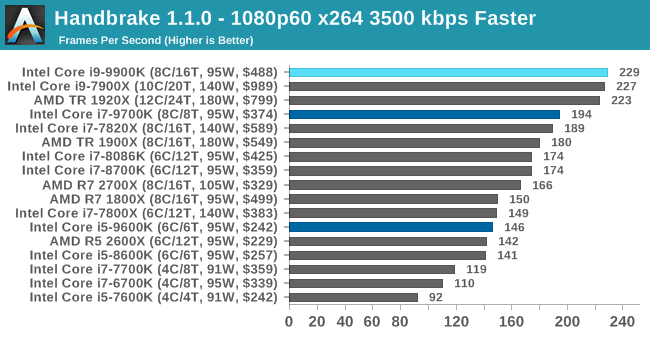
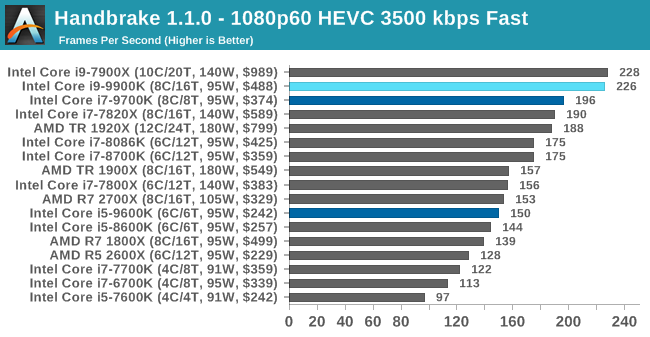
7-zip v1805: Popular Open-Source Encoding Engine
Out of our compression/decompression tool tests, 7-zip is the most requested and comes with a built-in benchmark. For our test suite, we’ve pulled the latest version of the software and we run the benchmark from the command line, reporting the compression, decompression, and a combined score.
It is noted in this benchmark that the latest multi-die processors have very bi-modal performance between compression and decompression, performing well in one and badly in the other. There are also discussions around how the Windows Scheduler is implementing every thread. As we get more results, it will be interesting to see how this plays out.
Please note, if you plan to share out the Compression graph, please include the Decompression one. Otherwise you’re only presenting half a picture.
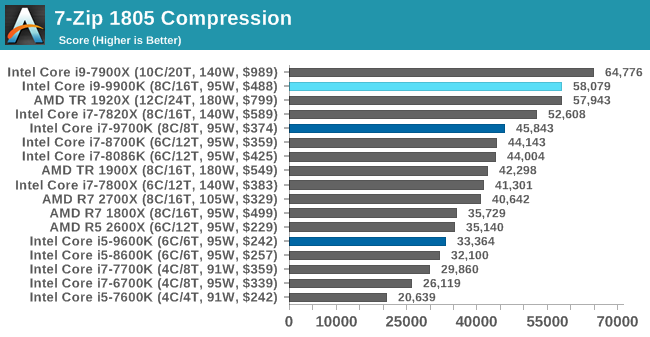
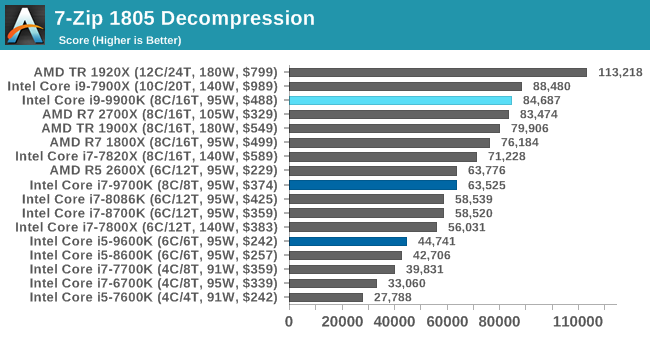
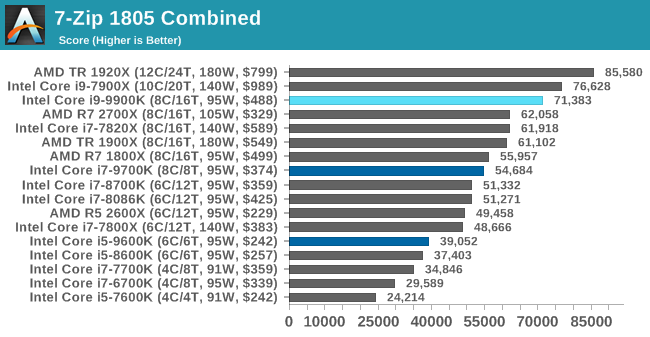
WinRAR 5.60b3: Archiving Tool
My compression tool of choice is often WinRAR, having been one of the first tools a number of my generation used over two decades ago. The interface has not changed much, although the integration with Windows right click commands is always a plus. It has no in-built test, so we run a compression over a set directory containing over thirty 60-second video files and 2000 small web-based files at a normal compression rate.
WinRAR is variable threaded but also susceptible to caching, so in our test we run it 10 times and take the average of the last five, leaving the test purely for raw CPU compute performance.
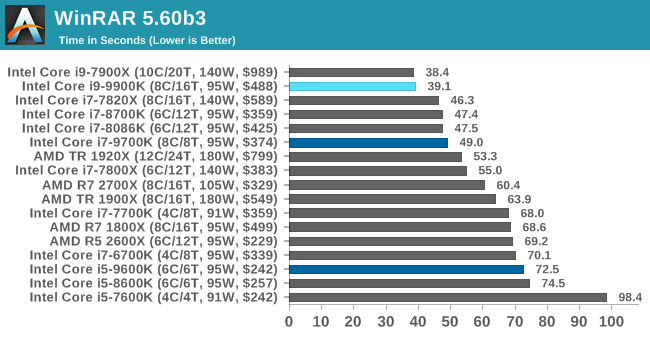
AES Encryption: File Security
A number of platforms, particularly mobile devices, are now offering encryption by default with file systems in order to protect the contents. Windows based devices have these options as well, often applied by BitLocker or third-party software. In our AES encryption test, we used the discontinued TrueCrypt for its built-in benchmark, which tests several encryption algorithms directly in memory.
The data we take for this test is the combined AES encrypt/decrypt performance, measured in gigabytes per second. The software does use AES commands for processors that offer hardware selection, however not AVX-512.
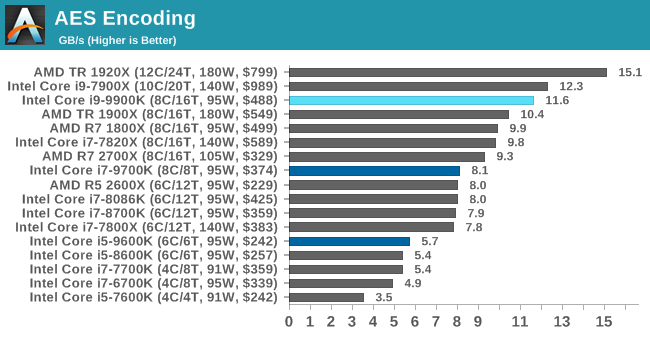










274 Comments
View All Comments
Ian Cutress - Monday, October 22, 2018 - link
Emn13: Base code with compiler optimizations only, such as those a non-CompSci scientist would use, as was the original intention of the 3DPM test, vs hand tuned AVX/AVX2/AVX512 code.just4U - Saturday, October 20, 2018 - link
The only problem I really have with the product is for the price it should have come with a nice fancy cooler like the 2700x which is in it's own right a stellar product at close to 60% of the cost. Not sure what intel's game plan is with this but It's priced close to a second gen entry threadripper and for it's cost you might as well just make the leap for a little more.khanikun - Monday, October 22, 2018 - link
I'm the other way. I'd much rather they lower the cost and have no cooler. Although, Intel doesn't decrease the cost without the cooler, which sucks.I'm either getting a new waterblock or drilling holes in the waterblock bracket to make it fit. Well I just upgraded, so I'm not in the market for any of these procs.
brunis.dk - Saturday, October 20, 2018 - link
no prayers for AMD?ingwe - Friday, October 19, 2018 - link
I don't see the value in it though I understand that this isn't sold as a value proposition--it is sold for performance. Seems to do the job it sets out to do but isn't spectacularly exciting to me.jospoortvliet - Saturday, October 20, 2018 - link
Given how the quoted prices ignore the fact that right now Intel CPU prices art 30-50% higher than MSRP, yes, nobody thinking about value for money buys these...DanNeely - Friday, October 19, 2018 - link
Seriously though, I'm wondering about the handful of benchmarks that showed the i7 beating the i9 by significant amounts. 1-2% I assume is sampling noise in cases where the two are tied, but flipping through the article I saw a few where the i7 won by significant margins.Ian Cutress - Friday, October 19, 2018 - link
Certain benchmarks seem to be core-resource bound. In HT mode, certain elements of the core are statically partitioned, giving each thread half, and if only one thread is there, you still only get half. With no HT, a thread gets the full core to work with.0ldman79 - Friday, October 19, 2018 - link
I'd love to see some low level data on the i5 vs i7 on that topic.If the i5 is only missing HT then the i7 without HT should score identically (more or less) with the i5 winning on occasion vs the HT enabled i7. I always figured there was a significant bit of idle resources (ALU pipelines) in the i5 vs the i7, HT allowed 100% (or as close as possible) usage of all of the pipelines.
I wish Intel would release detailed info on that.
abufrejoval - Friday, October 19, 2018 - link
Well I guess you should be able to measure, if you have the chips. My understanding has alway been, that i7/i5 differentiation is all about voltage levels with i5 parts needing too much voltage/power to pass the TDP restrictions rather than defective logic precluding the use of 'one hyperthread'. I find it hard to imagine managing defects via partitions in the register file or by disabling certain ALUs: If core CPU logic is hit with a defect it's dead, because you can't isolate and route around the defective part at that granularity. It's the voltage levels on the long wires that determine a CPUs fate AFAIK.It's a free choice between a lower clock and HT or the higher clock without HT at the binning point and Intel will determine the fate of a chips on sales opportunities rather than hardware. And it's somewhat similar with the fully enabled lower power -T parts and the high-frequency -K parts, which are most likely the same (or very similar) top tier bins, sold at two distinct voltage levels yet rather similar premium prices, because you trade power and clocks and pay premium for efficiency.
Real chips defects can only be 'compensated' via cutting off cache blocks or whole cores, but again I'd tend to think that even that will be more driven by voltage considerations than 'hairs in the soup': With all this multi-patterning and multi-masking going on and the 3D structures they are lovingly creating for every FinFeT their control over the basic structures is so great, that it's mainly the layer alignment/conductivity that's challenging the yields.